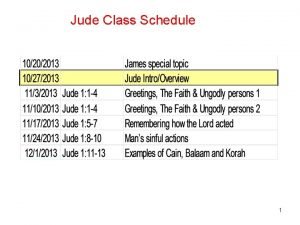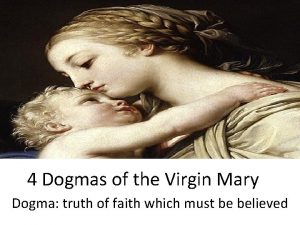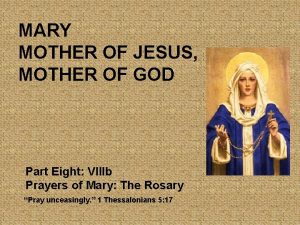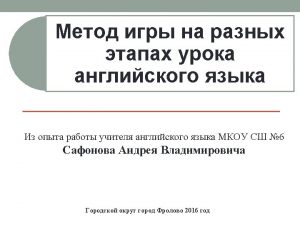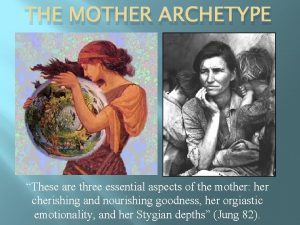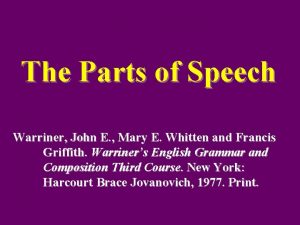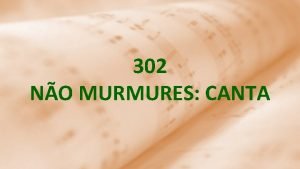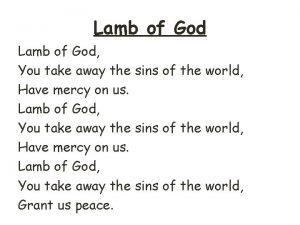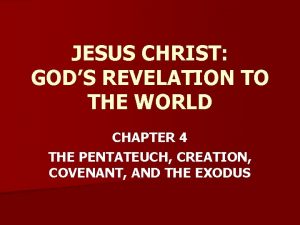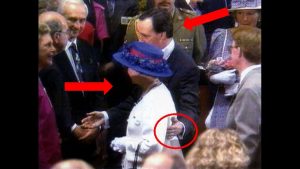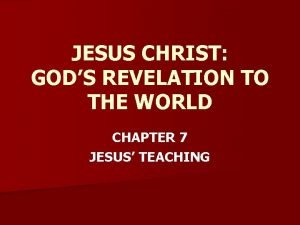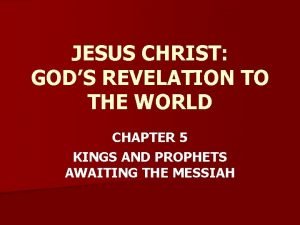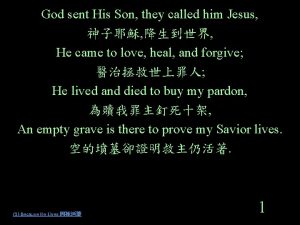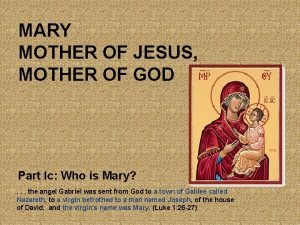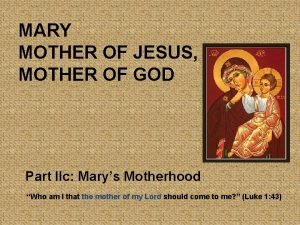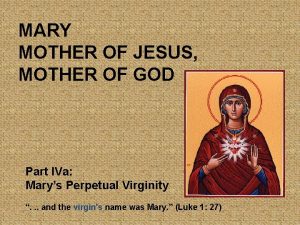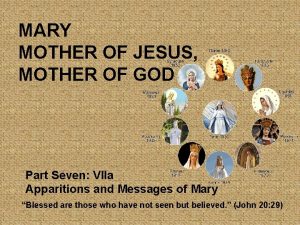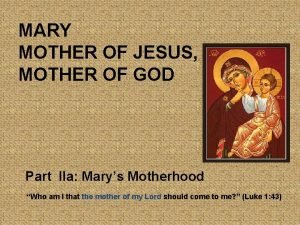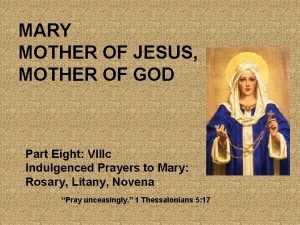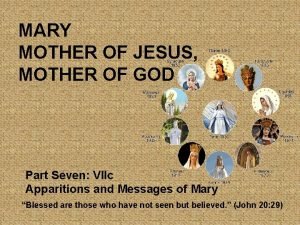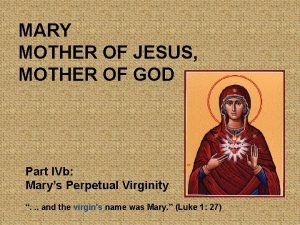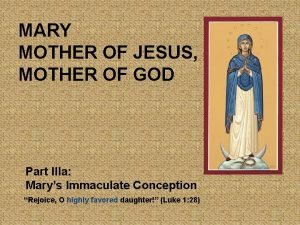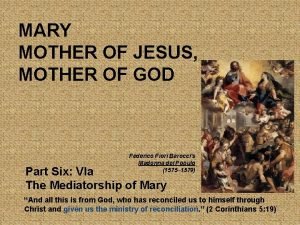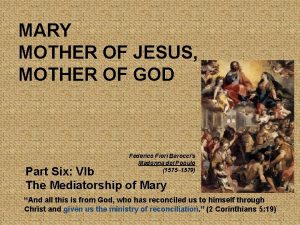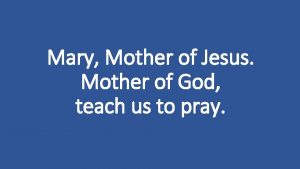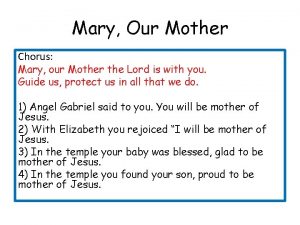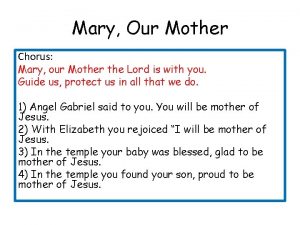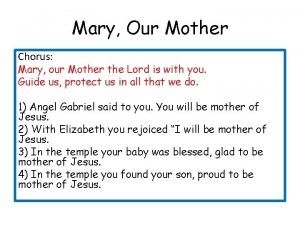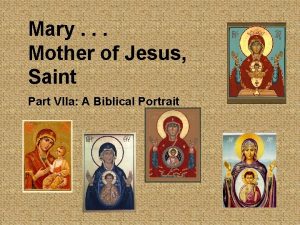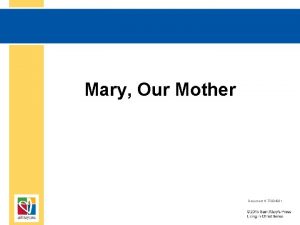MARY MOTHER OF JESUS MOTHER OF GOD Part






















- Slides: 22

MARY MOTHER OF JESUS, MOTHER OF GOD Part Ia: Who is Mary? . . . the angel Gabriel was sent from God to a town of Galilee called Nazareth, to a virgin betrothed to a man named Joseph, of the house of David, and the virgin's name was Mary. (Luke 1: 26 -27)

Mary: How is She Called, How Shall We Call Her? Mary Judeo-Aramaic: מרים , Maryām, from Hebrew Miriam, Greek Μαριαμ or Μαρια, in Arabic Maryam, and called since medieval times Madonna (My Lady), resident in Nazareth in Galilee, known from the New Testament as the mother of Jesus of Nazareth. The New Testament describes her as a young virgin, who conceived by the agency of the Holy Spirit while she was already the betrothed wife of Joseph of the House of David and awaiting their imminent formal home-taking ceremony (the concluding Jewish wedding rite).

Mary: An Introduction The teachings of Catholic Christianity about the role of Mary, the Mother of Jesus, are some of the most misunderstood and exaggerated beliefs dividing the Body of Christ. Before presenting the teaching of the Church about Mary, there are some important givens or assumptions to be stated about the Church, Mary and the Bible. The official teaching of the Church has never considered beliefs about Mary to be in any way equal in importance to truths about God the Father, Jesus Christ the Son of God, and the Holy Spirit.

Vatican Council II expressed it best when the Council Fathers wrote: On Ecumenism, No. 11. . . in Catholic doctrine there exists an order or “hierarchy” of truths, because they vary in their relation to the foundation of the Christian faith.

The truths about Mary are important because they are still truth, because they are based in the Bible. But they are not central to the primary gospel message of our salvation through Jesus Christ. As an example of the basic gospel message without Mary, we have only to look at the writings of Paul. In Pauline theology, Mary is mentioned only once, and not even by name. Galatians 4: 4 But when the fullness of time had come, God sent his Son, born of a woman, born under the law, . . .

Catholics believe that the understanding of the Church about Mary, as about all Christian truth (e. g. , the understanding of the Trinity) deepens and becomes more accurate over the centuries under the guidance of the Holy Spirit. John 15: 26 When the Advocate comes whom I will send you from the Father, the Spirit of truth that proceeds from the Father, he will testify to me. John 16: 12 -13 I have much more to tell you, but you cannot bear it now. But when he comes, the Spirit of truth, he will guide you to all truth.

When the Catholic Church appears to teach “new doctrines” about Mary, it is often a statement of truth against some current errors or a clarification of truths that have always been taught and believed by Christians through the centuries. The Church believes that handing on these truths participates in the admonition of Paul. 2 Thessalonians 2: 15 Therefore, brothers, stand firm and hold fast to the traditions that you were taught, either by an oral statement (our word) or by a letter (written tradition) of ours.

On the Church, No. 67, Vatican Council II The sacred synod. . . strongly urges theologians and preachers of the word of God to be careful to refrain as much from all false exaggeration as from too summary an attitude in considering the special dignity of the Mother of God. Following the study of Sacred Scripture, the Fathers, the doctors and liturgy of the Church, and under the guidance of the Church's magisterium, let them rightly illustrate the duties and privileges of the Blessed Virgin which always refer to Christ, the source of all truth, sanctity, and devotion. 1963 100 200 300 400 500 600 700 800 900 1000 1100 1200 1300 1400 1500 1600 1700 1800 1900

Consequently, two fundamental criteria guide the teaching authority of the Catholic Church as it seeks to discern what are the authentic beliefs about Mary which Jesus through His Holy Spirit would have us know: No belief can contradict anything faithfully handed down from the Apostles either in the written tradition, the Bible, or in the oral tradition of the Church; Any truth which develops under the guidance of the Holy Spirit and reflection upon the deposit of revelation must be demonstrated to have been accepted over a long period of time by the People of God.

Major Resources Protoevangelium of James http: //www. newadvent. org/fathers/0847. htm The Gospel of James, also sometimes known as the Infancy Gospel of James or the Protoevangelium of James, is an apocryphal Gospel. New Testament apocrypha are a number of writings of the early Christian church that give accounts of the teachings of Jesus, aspects of the life of Jesus, accounts of the nature of God, or the teachings of his apostles and of their lives. Probably written about AD 150. The Gospel of James may be the earliest surviving document attesting the veneration of Mary by stating her perpetual virginity.

The document presents itself as written by James: “I, James, wrote this History in Jerusalem. ” Thus the purported author is James the Just also known as James of Jerusalem, James Adelphotheos, James, the Brother of the Lord. He was an important figure in Early Christianity, whom the text claims is a son of Joseph from a prior marriage, and thus a stepbrother of Jesus or a cousin of Jesus, or a kinsman. Scholars have established that, based on the style of the language, and the fact that the author is apparently not aware of contemporary Jewish customs while James the Just certainly was, the work is apocryphal. The Protoevangelium of James is almost certainly not by James nor is it entirely factual. The early Church mostly didn’t think it was inspired, either, i. e. , non-canonical. However, this second century work has survived in over 130 manuscripts. That’s popularity. It’s an interesting blend of Bible and oral tradition. The Church has traditionally accepted it as containing a few grains of truth, such as the names of Mary’s parents, Anna and Joachim.

At times, the translation is jumbled because the manuscripts are pretty jumbled, too. The author of this piece took the Eastern view that James the Less was Joseph’s son by a previous marriage, not the Western view that James was Jesus’ cousin. However, since Joseph and Mary were apparently cousins, and Aramaic uses the word “brother” for every sort of cousin there is, both interpretations could in fact be true. In Middle Eastern tribal life, marrying some cousin is almost unavoidable, if you marry inside your tribe.

The Story (History) of Joseph the Carpenter or the Gospel of Joseph the Carpenter. http: //www. newadvent. org/fathers/0805. htm To the class of gospel compositions belongs the Gospel of Joseph the Carpenter. Originally written in Coptic, it was translated into Arabic, in which language, with a Latin version, it was published in 1722. The composition is devoted to the glorification of Joseph, a devotion which was specially favored by the monophysite Coptics. It dates from the 4 th Century (300 s). It contains in 22 chapters the whole history of Joseph and relates in the last part the circumstances of his death at the age of 111 years. These are of some importance for the history of dogma.

Guardian of the Redeemer (Redemptoris Custos) Apostolic Exhortation of Pope John Paul II, on the Person and Mission of Saint Joseph in the Life of Christ and the Church. Promulgated on August 15, 1989. Addressed to Bishops, to Priests and Deacons, to Men and Women Religious, and to all the Lay Faithful. http: //www. crossroadsinitiative. com/library_article/500/St. _Joseph_ Guardian_of_the_Redeemer_John_Paul_II_Redemptoris_Custos. html

After the Marian Year with its many Marian documents Pope John Paul II presented a document on Saint Joseph. Jesus Christ was born into a family. Mary was given the companionship of Joseph to provide that unit recognized as the most fundamental cell of society, the family. Redemptoris Custos defines the relationships among Jesus, Mary and Joseph. For instance, the document states, “And while it is important for the Church to profess the virginal conception of Jesus, it is no less important to uphold Mary's marriage to Joseph, because juridically Joseph's fatherhood depends on it. ” (7) Joseph has accepted the legal responsibilities of fatherhood. He does everything that is required of that responsibility. This is what constituted the family, and in the case of Jesus, Mary and Joseph, the holy family. A quote inserted from Pope Leo XIII helps to define Joseph's role: It is certain that the dignity of the Mother of God is so exalted that nothing could be more sublime; yet because Mary was united to Joseph by the bond of marriage, there can be no doubt but that Joseph approached as no other person ever could that eminent dignity whereby the Mother of God towers above all creatures.

Because marriage is the highest degree of association and friendship, Involving by its very nature a communion of goods, it follows that God, by giving Joseph to the Virgin, did not give him to her only as a companion for life, a witness of her virginity and protector of her honor: he also gave Joseph to Mary in order that he might share, through the marriage pact, in her own sublime greatness. (20) The greatness of Mary and Joseph consists in their holiness, in the pure gift of grace they experience by dwelling with the Lord Jesus Christ. But the gift does not immune them from the daily struggles that pertain to every family. Although the Gospel relates snippets of the struggles in the Infancy Narratives, the greater part of the daily routine of marriage and family life remain hidden. As the document states, “All of the so-called ‘private’ or ‘hidden’ life of Jesus is entrusted to Joseph's guardianship. ” (8)

Revelation: Public and Private Revelation is simply information revealed by God, especially if the mode of its revelation is supernatural or if the knowledge could not have been had apart from revelation. Revelation from God needs, as the Church has always done, a distinction between public revelation and private revelation, and private revelation and private devotion. June 26, 2000, Congregation for the Doctrine of the Faith, promulgated The Message of Fatima under Joseph Cardinal Ratzinger pointed out that “the teaching of the Church distinguishes between ‘public Revelation’ and ‘private revelation. ’ The two realities differ not only in degree but also in essence. ” The difference between public and private revelation is not simply that public revelation is given to or binding on all whereas private revelation is given to or binding on only some restricted by time, place, or identity).

Public and private are two different kinds of revelation. “The term ‘public Revelation’ refers to the revealing action of God directed to humanity as a whole and which finds its literary expression in the two parts of the Bible: the Old and New Testaments, ” wrote Cardinal Ratzinger. “It is called ‘Revelation’ because in it God gradually made himself known to men, to the point of becoming man himself, in order to draw to himself the whole world and unite it with himself through his Incarnate Son, Jesus Christ. It is not a matter therefore of [merely] intellectual communication, but of a life-giving process in which God comes to meet man. ” Public revelation, Cardinal Ratzinger stressed, came to an end with God’s definitive Word to mankind--Jesus Christ--and with the New Testament. It is contrasted with “the concept of ‘private revelation, ’ which refers to all the visions and revelations which have taken place since the completion of the New Testament. ”

Private revelation is different from public revelation in several important respects: “The authority of private revelations is essentially different from that of the definitive public Revelation. The latter demands faith; in it in fact God himself speaks to us through human words and the mediation of the living community of the Church. Faith in God and in his word is different from any other human faith, trust, or opinion. The certainty that it is God who is speaking gives me the assurance that I am in touch with truth itself. It gives me a certitude which is beyond verification by any human way of knowing. ” Private revelation serves as a help to this divine and Catholic faith but does not itself demand this faith: “. . . the future Pope Benedict XVI, said in his classic treatise, which later became normative for beatifications and canonizations: “An assent of Catholic faith is not due to revelations approved in this way; it is not even possible. These revelations seek rather an assent of human faith in keeping with the requirements of prudence, which puts them before us as probable and credible to piety. ”

Because they do not require divine and Catholic faith, private revelations do not impose an obligation of belief of the sort that public revelation does. To disbelieve knowingly and deliberately anything God has revealed in such a way (public revelation) that it requires divine and Catholic faith is to commit mortal sin. However, since God has not issued private revelations with this degree of certainty, the burden is not imposed. Thus, “such a message can be a genuine help in understanding the Gospel and living it better at a particular moment in time; therefore it should not be disregarded. It is a help which is offered, but which one is not obliged to use. ”

Private devotion is a prayer form which is not part of the official public liturgy of the Church but are part of the popular spiritual practices of Catholics. Private devotions are encompassed within that definition which are done privately or with a small group. An example of this would be a group devoted to the image of Our Lady of Perpetual Help. Or a group which makes a consecration to the Sacred Heart. Or Divine Mercy Sunday. What is the difference between personal and private devotion? Personal devotion would be this: You personally find solace in Divine Mercy, while I may not. I personally find solace in Our Lady of Lourdes while you may not. Or on a more controversial note, One may find complete and full solace in Medjugorje, while another may be utterly and completely opposed thinking that it is a hoax. Another form of personal devotion could manifest itself in the fact that I pray the Divine Office everyday. There is no mandate that I do so (only priests and deacons are canonically required to do so), but I find comfort in that part of my prayer life, while many may not find any use for it at all.

The End of Mary the Series, Who Is Mary Part Ia Go to Mary the Series, Who Is Mary Part Ib
 Judas vs judah
Judas vs judah Mary dogmas
Mary dogmas Prayer to mary mother of god
Prayer to mary mother of god Jesus jesus jesus sweetest name i know
Jesus jesus jesus sweetest name i know Jesus jesus jesus in the morning
Jesus jesus jesus in the morning Mary wollstonecraft mary a fiction
Mary wollstonecraft mary a fiction Mary magdalene jesus wife
Mary magdalene jesus wife Dictation in english
Dictation in english The earth mother archetype examples
The earth mother archetype examples Mary parts of speech
Mary parts of speech Jesus you are my lord jesus you are my everything
Jesus you are my lord jesus you are my everything Ao invés de murmurares canta
Ao invés de murmurares canta Jesus jesus how i trust him
Jesus jesus how i trust him Kerygmatisch jesus
Kerygmatisch jesus @jesus david pineda j:men. swap part 1
@jesus david pineda j:men. swap part 1 You take away the sins of the world have mercy on us
You take away the sins of the world have mercy on us Love love jesus is love god greatest gift lyrics
Love love jesus is love god greatest gift lyrics Jesus christ god's revelation to the world answers
Jesus christ god's revelation to the world answers Jesus christ god's revelation to the world
Jesus christ god's revelation to the world Jesus christ in very nature god
Jesus christ in very nature god Jesus christ god's revelation to the world
Jesus christ god's revelation to the world Jesus christ god's revelation to the world chapter 5
Jesus christ god's revelation to the world chapter 5 God sent his son they called him jesus
God sent his son they called him jesus
